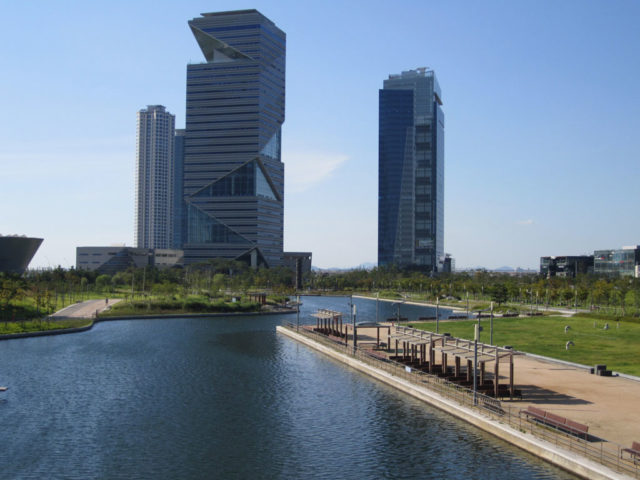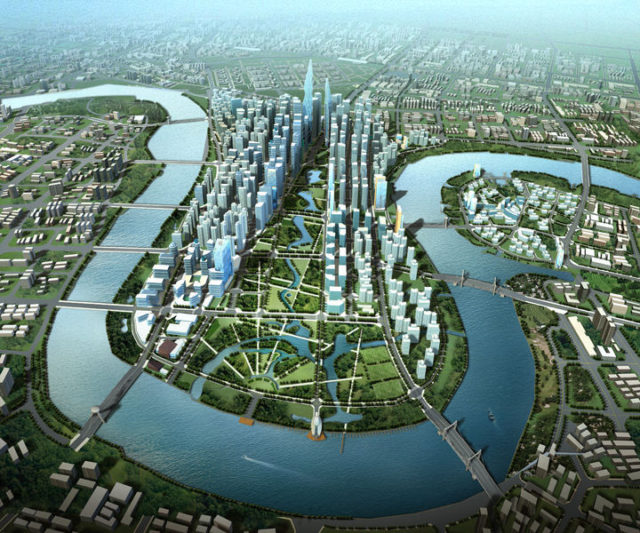Reflections Upon the Promise of New Cities
April 10, 2015 — Blog
Today, most of the world’s population lives in cities, and the number of people moving into urban centers is rapidly increasing. This is exacerbating issues such as air pollution, traffic congestion and a shortage of affordable housing. On top of this, 67 per cent of the total global energy consumption is disproportionally concentrated within cities.
At this rate, cities cannot be sustained further. Could new cities provide a way to tackle this challenge? I would argue that new urban centers, built from scratch, are proving to be significant testing grounds for urban innovations.

On December 8-9, 2014, I attended Cityquest – KAEC Forum, a global event on the future of new cities. The event took place in King Abdullah Economic City (KAEC), a major urban mega project in Saudi Arabia. It is part of the Cityquest initiative, a community of leaders and builders of new cities, led by the New Cities Foundation and KAEC.
I spent the past five months living in KAEC as an Impact KAEC Fellow. The Fellowship offered me, along with two other Harvard GSD graduates, the opportunity to live and work in a brand new city and help shape its evolution. It was fascinating to attend the Forum in December and to hear insights from many of the key players involved in global new city developments. The role of new technologies in building the connected city was a central discussion point.
A documentary presented during the Forum explored how smart systems and hard infrastructure can reshape the city. Songdo, South Korea, was highlighted as a new city that integrates smart technologies throughout its infrastructure. Utilizing South Korea’s growing IT industry, Songdo has implemented self-monitoring infrastructure to regulate its energy consumption and to monitor its temperature and traffic. Even the waste management infrastructure is ‘smart’: all the city’s waste is processed in an underground network that automatically recycles and treats it as required. Songdo’s waste management system aims to convert the treated waste into renewable energy, which will be used to support the business district.
In the documentary, I was fascinated to watch a Songdo resident talking about her experience as a citizen in this futuristic city. She explained how smart networks are having a positive impact on her daily life. She said she feels safer as a result of the installed CCTVs around the city. She also explained the ways in which sensors can enable citizens to control their energy consumption.

Similarly, Tianjin Eco-city in China – a participant at the Forum – provides better environmental conditions compared to other cities in the country. Many residents express a significant sense of pride toward their low-carbon city. Both Songdo and Tianjin Eco-City are planned and constructed from scratch, implementing advanced but feasible high-tech infrastructure. Thanks to this infrastructure, the cities can test out new ways of connecting people with their surroundings and with each other. For example, smart machines record energy consumption of individual apartments. Residents are able to monitor their own consumption and also that of their neighbors. As an incentive, Songdo’s most energy efficient residents win free access to the community gym for a certain period of time. This system sparks more active community engagement in sustainable living. In this way, citizens of both new cities are living in a brand new “smart system” that has never existed before.
New cities can be valuable testing grounds for unusual inventions pioneered by engineers, designers and entrepreneurs. For example, Kent Larson, Director of MIT Media Lab’s Changing Places Research Group, had some exciting examples to offer during Cityquest – KAEC Forum. The research group has designed a folding vehicle as a prototype mobility solution for cities seeking sustainable mobility options. The vehicle occupies only a tiny footprint when folded, using a parking space that is seven times smaller than that of a standard car. In response, streets will be adapted to fit the vehicles, becoming narrower than regular roads. New cities would benefit from adopting these vehicles, saving street and parking space for public developments such as parks. Utilizing shared-electric vehicles could also have a substantial impact on carbon emissions. New cities allow the feasibility of these cars to be tested, whereas matured cities may be too crowded to adopt these ideas.
Another new solution can be found in the ‘robotic wall’, which can be installed in conventional apartment spaces to maximize its utility. The challenge today is that the urban population is increasing, and space in existing cities is limited. Perhaps the robotic wall could help solve this problem by converting a standard micro unit space of 800 square feet into a multi-functional area. This is made possible by a technology-enabled infill wall that can be customized for the owner’s needs and activities. For example, an office space can transform into a sports area with a treadmill that can fold down from the wall. The area can in turn become a dining room, by extending foldable tables and moving the wall away to create more space.
Daan Roosegaarde, designer and founder of Studio Roosegaarde in the Netherlands, conceived the Smart Highway, which creates glow-in-the-dark lights on road surfaces. The lights are created with a special kind of paint that absorbs solar energy during the day and then illuminates at night. The lights offer a safe way of ensuring road safety, whilst also injecting beauty and color into an otherwise somber urban construction. This invention could be tested in new cities to help reduce urban energy consumption by decreasing the demand for streetlights. However, in cities with existing advanced streetlight infrastructure, the cost of the Smart Highway may outweigh the potential benefits of this urban design concept. This is another example of how new cities are in an advantaged position when it comes to testing out new high-tech solutions.
These examples demonstrate how we can embrace advanced technology to live more efficiently, comfortably and creatively in a rapidly urbanizing world. As the cases of Songdo and Tianjin Eco-city suggest, new, smart infrastructure networks encourage citizens to actively engage in their surroundings. Automatic waste management services make recycling simple. Similarly, flexible and scalable smart interventions such as the robotic wall, folding cars and glowing Smart Highways can transform the urban living environment by increasing efficiency, comfort and design appeal.
Ultimately, new cities are in many ways the ideal laboratory for prototyping new technological innovations. They can act as models for new practices and modes of living, with particular attention to global imperatives such as sustainability. In this way, these growing cities have the potential not only to be smart, but also to be creative.